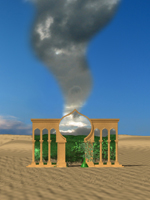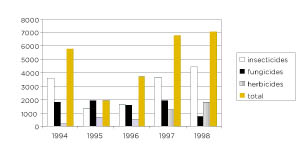|
|
Vol.
26 No. 2
March-April 2004
Green Chemistry in the Arab Region: One Step Further in IUPAC’s Campaign to Promote Sustainability and Chemistry
by Pietro Tundo and Mohamed Tawfic Ahmed
 |
| © F. Tundo, 2004 |
Green chemistry is an emerging field concerned with the safe practice of chemistry—a goal that people all over the world are interested in attaining. Green chemistry addresses some of our most precious values: human well-being, environmental sustainability, integrity, and safety, and the worldwide need for green chemistry practices should allow human development and prosperity, along with environmental ethics.
The IUPAC Working Party on Synthetic Pathways and Processes in Green Chemistry defined Green Chemistry (2000) as “The invention, design, and application of chemical products and processes to reduce or to eliminate the use and generation of hazardous substances.”
More recently, the European Union’s COST Action D29 on Sustainable/Green Chemistry and Chemical Technology (2003) gave a more comprehensive definition: “Design of products for sustainable applications, and their production by molecular transformations that are energy efficient, minimise or preferably eliminate the formation of waste and the use of toxic and/or hazardous solvents and reagents and utilize renewable raw materials where possible.”
The Arab region, which stretches from the Atlantic Ocean to the Persian Gulf, embraces a population of nearly 250 million spread over about 26 different nations. In most of these countries, the demand for green chemistry emerged after almost half a century of “chemical mania.” However, poor chemical practices during this period resulted in harsh experiences and bitter loss. Following are just a few examples:
- The massive poisoning in Morocco in 1959 that resulted from the contamination of edible oil with tri-ortho-cresyl phosphate (TOCP) caused the severe illness or death of about 10 000 people
- In Egypt, the irrational use of pesticides triggered a number of environmental and health problems that most Egyptians still sombrely remember. Probably the most dramatic incidents occurred in 1971, 1973 and again in 1976 when neurotoxic organophosphates caused the widespread poisoning and death of about 35 pesticide operators and hundreds of farm animals. Similar incidences of pesticides-caused poisonings were reported in Saudi Arabia (1975), United Arab Emirates (1982), Yemin (1982), and Abdelhamid and Abdelmagead (1996). (Chart below illustrates importation of pesticides in Egypt.)
- Large-scale use of organochlorine insecticides has also inflicted great harm on Egypt’s environment, causing significant loss of biodiversity. Similarly, the extensive use of pesticides in Gulf states has caused some serious damage to wildlife and ecosystems.
- In 1972 in Iraq, more than 6000 people were poisoned or killed after consuming imported mercury-treated wheat. Similar instances of pesticide poisoning, although probably on smaller scales, were reported in Saudi Arabia, Sudan, Jordan, and Syria during the 1970s and 1980s.
Annual Importation of Pesticides in Egypt (in tons) |
 |
In other parts of the Arab world, where oil is the major source of revenue, another form of “chemical mania” resulted in a different set of problems. The massive volumes of waste generated from the oil industry and oil shipping have fouled the environment and affected people and wildlife.
It has become clear that levels of toxicants, especially those suspected of being carcinogenic, are much higher in the marine ecosystem of the Gulf countries than in international waters. Similarly, in these countries the residues of noxious gases such as ozone, sulphur dioxide, carbon monoxide, and many others exceed international permissible levels.
With the prevailing trend of industrialization and urbanization in almost all Arab countries, some other environmental and health problem have started to unfold. A recent World Bank report (No 25175- EGT) estimated that the cost of environmental degradation in Egypt in 1999 was 10-19 billion Egyptian pounds, or 3.2% to 6.4 % of the country’s gross domestic product (GDP), with a mean estimate of 14.5 billion Egyptian pounds (LE) or 4.8 % of GDP. (See table for more details.)
Annual Cost (in millions of Egyptian pounds) of Environmental Degredation (mean estimate) |
| |
Million LE per year |
Percent of GDP |
Air |
6 400 |
21% |
Soil |
3 600 |
12% |
Water |
2 900 |
10% |
Coastal zones and cultural heritage |
1 000 |
3% |
Waste |
600 |
2% |
Sub-Total |
14 500 |
4.8% |
Global environment |
1 900 |
6% |
Total |
16 400 |
5.4% |
Lead levels in Cairo are among the highest in the world, and are estimated to cause between 15 000 and 20 000 deaths a year, according to a 1996 report by the Egyptian Environmental Affairs Agency.
Other reports (Bashy, 1987) have shown that in Egypt and Saudi Arabia, pollution from the cement industry is causing widespread health problems, including serious pulmonary disease, in people who live nearby. Meanwhile, the health impacts of phosphate mining and processing in Morocco are a major concern.
The need for green chemistry in the Arab world is great and the role it can play is significant. We propose to produce a book on green chemistry in the Arab world that could provide a much-needed, critical examination of how chemical practices need to change so that industry and agricultural can be sustainable and people and the environment can be healthier. Such a book would help educate decision makers in Arab countries about the validity of green chemistry. As we envision it, the book would show how green chemistry techniques can reduce risks, increase profits, and maintain environmental integrity and sustainability.
The book would capitalize on the experiences of a number of chemists from different Arab countries. The book would also draw from the experience of the Italian Interuniversity Consortium for Chemistry for Environment, which has endeavored to establish a foundation for green chemistry in some Arab countries south of the Mediterranean through a number of workshops, seminars, and joint activities.
References
World Bank, Arab Republic of Egypt, Cost Assessment of Environmental Degradation, Report No 25175, June, 2002.
Bashy, Abdollah, 1987, Suspended and Falling Dusts as Pollutants of Riady, The 10th Seminar of Biological Aspects in Saudi Arabic, quoted from Air Pollution, Soliman El Equaily and Bashir Grar, 1990, ( in Arabic)
Abdelhamid, Zaidan and Abdelmagaed, Mohamed, 1996, Chemical Pollutants and the Environment ( in Arabic). Pietro Tundo <[email protected]> is a professor at the University Ca' Foscari, Venice, Italy. Mohamed Tawfic Ahmed <[email protected]> is a professor at the Suez Canal University, Ismailia, Egypt.
www.iupac.org/projects/2003/2003-043-1-300.html
Page
last modified 3 March 2004.
Copyright © 2003-2004 International Union of Pure and
Applied Chemistry.
Questions regarding the website, please contact [email protected]
|